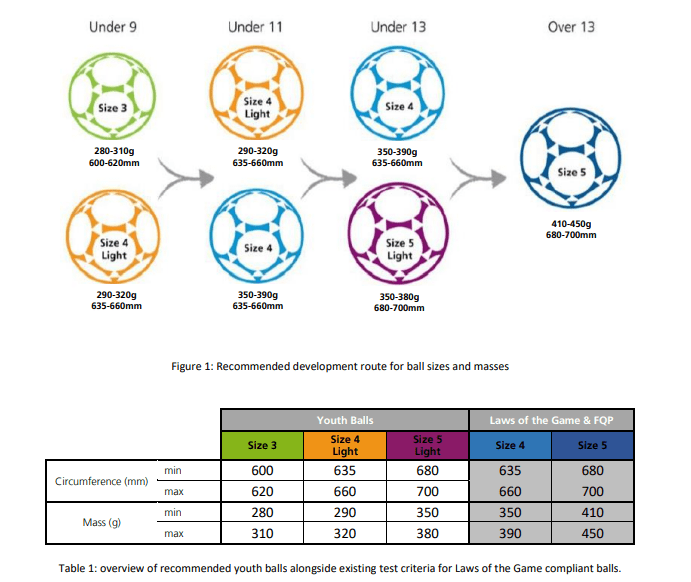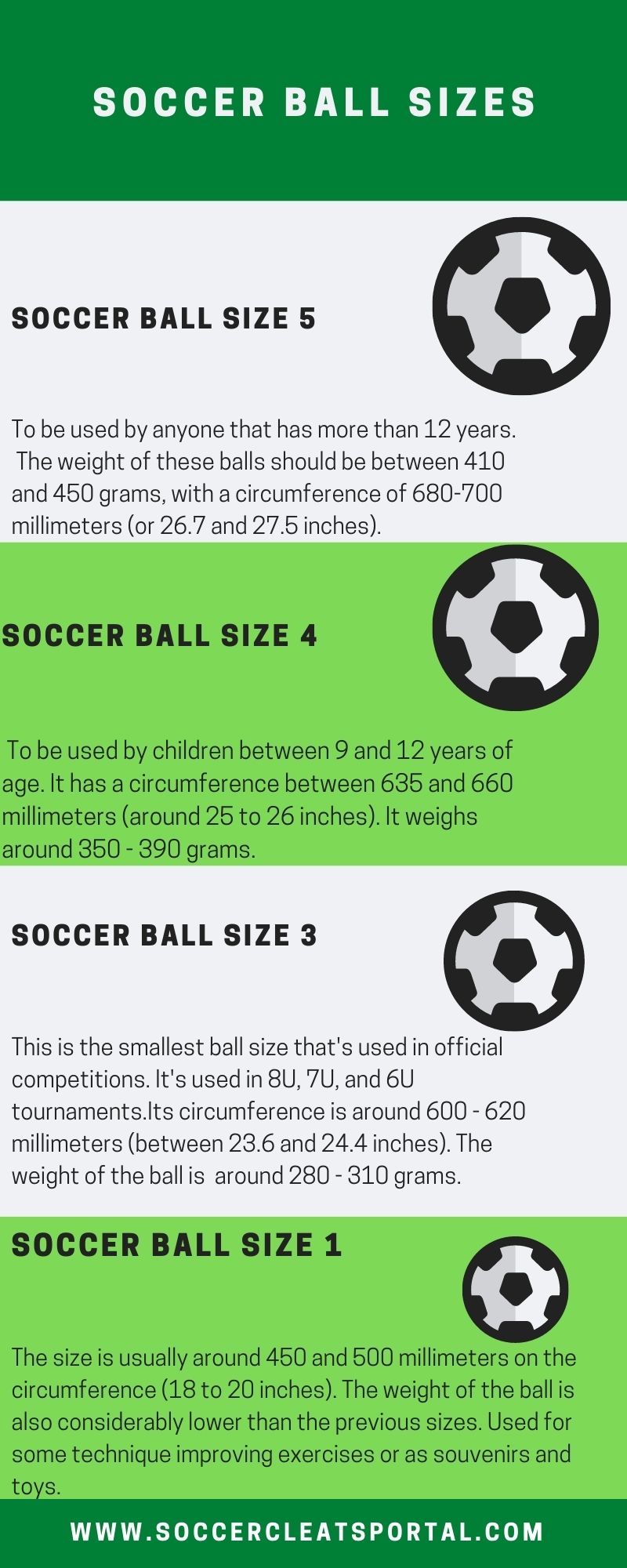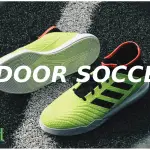When it comes to soccer balls, not all are created equally. There are 4 different sizes of soccer balls with the size 1 being the smallest and size 5 the largest. Knowing their differences will help tho choose the best one for your need.
Size 5 is going to be best for players of age 12 and older and have a circumference of 27 to 28 inches. Size 4 balls have a circumference of 26-27 inches and are for players 8-12 years old. For players at age 8 and younger a ball size, 3 will be the best option measuring 23-24 inches around. The smallest soccer balls, size 1, have 18-20 circumference.
It can be tricky to notice if you’re not paying attention, but because of the age of the players, some balls are made with a smaller circumference and less weight.
The different ball sizes are regulated by FIFA. So, how is this regulated and what balls are available for you to get for yourself or your kids?
What are the reasons for having different soccer ball sizes?
The reason for having different ball sizes is the proper development of the younger players.
Being an under 7 or an under 9 player your feet just aren’t big enough and your legs aren’t powerful enough to play with a ball that’s this big and this heavy. The younger players may experience some problems when controlling the heavier balls.
Playing soccer should be enjoyable for a kid. Playing with an inappropriate ball size will hamper their love and enjoyment of the game. Furthermore, it may also develop some bad habits that will be hard to fix once the player grows up.
Except for the difficulties in handling the ball, there is always the possibility of injury for the younger player when playing with larger and heavier balls. Κids can damage their ligaments and tendons if they kick a larger ball. Also, the concussion risk is significantly higher if trying the head a larger ball.
On the other hand, smaller soccer balls can be used by adult players for practice. A smaller ball is harder to juggle. Practicing with a smaller ball will improve your precision and overall ball handling.
Juggling with a smaller ball is one of the best soccer challenges that can help you to improve your footwork skills.
Official regulation regarding soccer ball sizes
Soccer balls may look simple at a first glance, however, their shape, size, and weight are strictly regulated by FIFA.
For professional play, all balls must have a circumference of 68 to 70 centimeters (between 27 and 28 inches). They must be spherical and made from suitable materials. Also, at the start of each match, balls must weigh between 410 and 450 grams (14 to 16 ounces). The pressure inside the soccer ball also considerably affects its shape. According to the propositions, the pressure must be somewhere between 0.6 – 1.1 atmospheres (600 – 1100 g/cm2) or 8.5 psi -15.6 psi.
For indoor soccer, according to the futsal laws of the game, the ball should have a circumference of not more than 64cm and not less than 62cm. The weight should be from 400 grams to 440 grams and the pressure must be somewhere between 0.6 – 0.9 atmospheres. So basically a size 4 soccer ball is more suitable for futsal.
For beach soccer, according to FIFA, the circumference is identical to a normal football (between 68 and 70 cm). The weight is from 400 to 440 grams and the pressure should between 0.375 and 0.8 bars.
In order to set specific quality requirements for soccer balls, FIFA has created The FIFA Quality Programme for Footballs which describes the test protocol and the quality requirements for all the different types of soccer balls.
In order for a ball to receive a FIFA approved badge and be able to be used in professional games according to the laws of the game, it must pass the tests described in that protocol.
What Are the Recommendations for Youth Soccer Ball Sizes?
In the past, many major companies in the soccer industry made requests to FIFA in regards to recommended sizes of youth soccer balls. There was a need to make uniform guidelines for using different ball sizes.
In response to this, the Football Quality Programme at FIFA did some precise research and gave an official overview of recommendations for ball sizes in youth soccer.
According to them, it’s advised for players over the age of 13 to use the size 5 soccer balls. These are also used in professional soccer. Players that are under 13 years of age should use either size 4 or the light variant of size 5 balls. The use of soccer ball size 4 or its light version is recommended for players that are under 11. Finally, players that are under 9 years of age should use soccer ball size 3 or the lightweight variant of size 4.

It’s important to say that these recommendations aren’t compulsory. When it comes to youth soccer each Federation has its own rules or recommendations. Note also that size can also vary in different leagues from the same Federation. So make sure to check with your coach or league officials to confirm tha you’re purchasing the right ball.
For Us Youth Soccer the general recommendations for the ball size for each age group is as follows: size 5 for over 13 years old, size 4 for U9-U12 and size 3 for U6 – U8 players.
What are the different soccer ball sizes?
We have seen the regulation and the reasoning behind different soccer ball sizing. Now let’s elaborate a little more on the different ball sizes.
Soccer Ball Size #5
Size 5 soccer balls are made to be used by anyone that has more than 12 years. This means that the first instance where a young player encounters this ball size is in 13U tournaments. 13U stands for any child under 13 years of age, but the vast majority of competing players are thirteen-year-olds.
The weight of these balls should be between 410 and 450 grams, with a circumference of 680-700 millimeters (or 26.7 and 27.5 inches).
This soccer ball size is used in all international and professional soccer matches. Any adult team competition will always use this type of soccer ball. Size 5 isn’t meant for young players as it’s considered to be too heavy for them to maneuver with.
It’s worth noting that there is a light variant of size 5 ball. It has the same circumference but it weighs around 50 grams less than a regular soccer ball. This variant is meant to be used in youth competitions.
Soccer Ball Size #4
As for size 4, it’s meant to be used by children between 9 and 12 years of age. This means that the balls of this side will be used in 12U, 11U, 10U, and 9U tournaments.
It’s a bit smaller than size 5, with a circumference between 635 and 660 millimeters (around 25 to 26 inches). The ball is also lighter than the one that’s used in professional soccer. It weighs around 350 – 390 grams.
This ball size is more commonly known as the medium-size soccer ball. It’s specifically designed for youth soccer games. Some young players that have a stronger body build can also play with a regular size 5 ball. However, most of the player population will still struggle to keep up with a larger ball. The size 4 soccer ball is a good stepstone in this transitioning phase where the players are still growing.
Just like soccer ball size 5, size 4 also has a lightweight variant. Identically to the previous case, it also weighs around 50 – 70 grams less than a regular size 4 ball.
Soccer Ball Size #3
This is the smallest ball size that’s used in official competitions. It’s used in 8U, 7U, and 6U tournaments. This means that this ball size is primarily used by children aged between 6 and 8.
Its circumference is around 600 – 620 millimeters (between 23.6 and 24.4 inches). Again, the weight of the ball is less than the previous size. It’s around 280 – 310 grams.
Size 3 soccer ball is usually used in soccer games on the junior level. Its dimensions are perfect for kids to practice and improve their ball-handling and passing. Young players need to play with appropriate ball sizes. If they start with soccer balls that are made for older players, kids could quickly get frustrated when playing or develop some bad habits.
Some adult players sometimes use this ball size to work on their ball control and handling skills. For kids that are 5 years old or younger, soccer ball size 2 is recommended.
Soccer Ball Size #1
Finally, we have the size 1 soccer ball. They can be used by all ages. These are relatively small balls that can be used for some technique improving exercises or as souvenirs and toys.
The size is usually around 450 and 500 millimeters on the circumference (18 to 20 inches). The weight of the ball is also considerably lower than the previous sizes.
These balls are most commonly referred to as “minis”. They often have a player or a club logo printed onto them. Minis aren’t used in any serious play and are mostly meant to serve as toys for children or collectibles for fans.
How to measure a soccer ball?
A used ball is much larger than it was originally. Every time you kick a soccer ball causes the strings to pull against the outer skin material which results in the ball expanding over time.
A ball can expand as much as 20% larger than it was when it was new. For this reason, is recommended that you measure your soccer ball circumference after each season and replace balls that have expanded outside the FIFA specifications.
Below are the simple steps that you can use to measure your ball size:
- First, you need to inflate the ball.
- Place the ball in the corner at a 90-degree angle. The ball should now touch in a flat surface and a wall.
- Measure the distance between the spot where the ball ends on the flat surface and the wall. This is the diameter of the ball.
- Multiply the measurement by 3.14 and the result would be the circumference of the ball in centimeters.
Another, more difficult way would be to draw a circle around the ball and measure the diameter and then make the calculations.
What is the proper air pressure for soccer balls?
We have seen that the smaller size soccer balls are lighter than a size 5 soccer ball. But what about the air pressure? Should this also be lower?
According the the laws of the game the pressure of a soccer ball should be between 0.6 – 1.1 atm, which is 600 – 1100 g/cm2 or 8.5–15.6 PSI. No distictions are made for lower size balls.
Of course, if you are not playing professionally you can inflate it to the level you feel comfortable. In any case each ball has a recommended pressure indication that you can follow.
Final thoughts
Selecting the proper ball size will not only give you better comfort and control, it will also make it easier to enjoy soccer.
Hopefully this guide will help you to find the correct ball for you or your kids.











